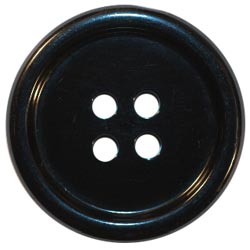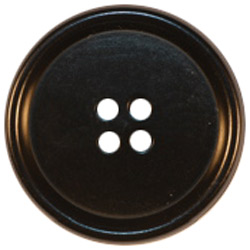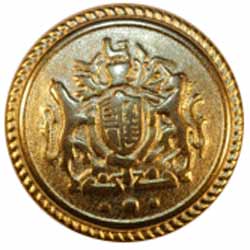Depending on how much research you have done, you may have noticed that some gents with a particular interest in style pay very close attention to the buttons on a suit jacket. This is primarily because, at the highest end of the spectrum, they are able to tell you a great deal about the quality of a garment.
The reason buttons carry so much weight is because after the cloth they are the most visible component of the suit, but often overlooked or handled cheaply by lower end manufactures.
The first thing to examine is the number of buttons on a sleeve. Although there is no real rule, I tend to think that the number of buttons on a sleeve should be equal to the number on the front of a suit plus two. So on your grey two button suit, you would expect four buttons on the sleeve. Similarly a three button suit would have five buttons on the sleeve. This is in no way a law, and many reputable tailors will put one more or less than this, but you should be aware that three buttons is too few (except on a one button tuxedo) and six is too many, which makes the sleeve look busy.
In fashion circles it is common to only add one or two buttons to a sleeve, in an effort to maintain a sleek and minimalist appearance. While there is nothing wrong with this approach, it is based on fashion rather than style, thus it will be outdated in a few years time. If you are willing to buy another suit every 18 months, then feel free to experiment with these looks.
The next element to consider is how the buttons are placed in relation to each other. There are three configurations that you may come across and each represents a stylistic choice rather than an indication of quality, though some are more costly and difficult than others.
You may see buttons that overlap each other slightly, which is referred to as waterfall. This is the most complex to sow, as even a few millimetres error makes for visible imperfections. With modern machinery this accuracy can be easily reproduced in factories across the world, so waterfall buttons no longer indicate the attention to detail that they one required.
If the buttons on a sleeve touch, but do not overlap they are referred to as “kissing” buttons. As with waterfall buttons there is no practical benefit to kissing buttons, they merely represent a preference by the designer.
The final options is for buttons that are sewn with space between them. This practice has more practical implications, including making the line of buttons stretch further up the arm, giving the cuff a heavier appearance (valuable on men with longer arms). Out of the three styles it is also the easiest to handle when shortening a sleeve, but realistically if your tailor can’t handle alterations on kissing buttons, then you probably shouldn’t be giving them your suit to work on.
After considering the number and placement of buttons, you come to the material they are made from. There are as many materials from which buttons can be made as there are materials on earth, so we will look at a few of the most common.
Plastic
By far the most common, until you reach the most expensive levels of suit, plastic has many advantages for tailors and suit wearers alike. Quite apart from the low cost of manufacture plastic can be made in any colour to coordinate with the cloth, made with logos imprinted, and supplied with a suit as replacements.
There was a time that plastic buttons indicated a lower quality of suit, but that has long since passed. In many instances brands producing reasonable products choose plastic simply because of its availability and durability.
The following types of button all represent more expensive materials and so will usually only appear on high-end suits. As with everything in life, their presence does not guarantee quality, but it will serve as a strong indicator.
Horn
Horn is the most traditional material from which Buttons are made, but it also ranks as some of the more expensive. For this reason only higher end suit makers use horn regularly. It can be difficult to tell the difference between plastic and horn without touching it, but there are a few telling markers: horn tends to be a matte finish, but even when polished it doesn’t have the same “gloss” as plastic, taking on an appearance more like polished wood. The discolouration on the surface of a horn button should run all the way through to the other side of the button, changing shape and hue slightly. Always remember that horn is a natural product that has grown on an animal, if all 10 buttons on the suit are carbon copies of each other, then it is unlikely that it is genuine.
Horn buttons work particularly well on dark suits, where a grey or brown button serves to highlight the colour of the suit without looking flashy.
Light Brown Horn
Mother of pearl
Mother of Pearl (MoP) is a significantly brighter material made from the shells of oysters. Buttons made from MoP are usually significantly thinner than horn or plastic, simply because of they way that they are sourced; each one is cut from a shell, so the thickness of the button is determined by the thickness of the shell being used. Although very hard to imitate well, you will always be able to tell of you have genuine MoP by the fact that it feels cooler to the touch than plastic, even under strong shop-lighting. Additionally there is always a “face” side of the button which shines and glows, and a “back” which is darker and less attractive. It is very rare for someone to polish and perfect both sides of a button when only one side will ever be seen.
There is a second, rarer style known as Smoked Mother of Pearl, which has a darker appearance, more reminiscent of gunmetal or unpolished steel. This is particularly nice when used on suits of navy blue as it gives a nice modern twist to the gold that usually accompanies blue. The lighter, un-smoked, versions look great with lighter suits such as a light grey or bright tan helping the suit look more modern and sleek.
Mother Of Pearl
Corozo
Corozo buttons are rare in England but an almost de facto choice for Italian tailors. Produced from the shell of a nut Corozo buttons are almost identical in appearance to plastic which has lead many manufacturers to simply use the cheaper alternative. While similar in appearance they are not identical with Corozo having a slight lustre to the surface and an altogether softer feel, more like soapstone. Interestingly the soft feel hides the fact that they are more resistant to scratching and chipping than plastic. I’m not sure that you need such protection unless you are a certain MI5 operative who gets into improbable scrapes while wearing his suit.
Popular for its deep cream and chocolate colours Corozo is a great choice for odd jackets and heavily patterned suits, particularly those made from linen. You may not be able to discern a difference from the plastic alternative, so ask the proprietor for help if you are unsure – if they went to the trouble of sourcing a rare nut to make buttons, they will certainly want to share that fact with you!
Black Corozo
Metal
I was unsure whether to include metals in this chapter as they do not appear on suits (at least not on suits that you should consider paying money for) but they often occur on blazers. Silver or gold buttons are placed on blazers in order to distinguish them from suit jackets that have been orphaned from their trousers. They are usually large and attached via a loop at the back rather than through the traditional two or four thread-holes. You will normally find that these buttons are created with a design on the surface; a crest or logo.
Based on old military uniforms these buttons sometimes made from solid gold and I have known guys pick up a blazer from the 1930s in a charity shop for £5 and sell the gold buttons for nearly £500 but this is a very rare occasion!
Generally speaking I find these buttons to be anachronistic, making the wearer either look like a stuffy retired general or someone “playing” at dressing well. If they are to your liking and suit your style they by all means go ahead, but I have seen only a few men pull this off with any success.





